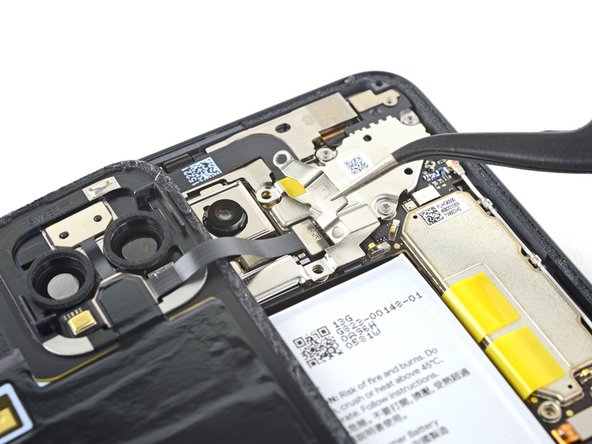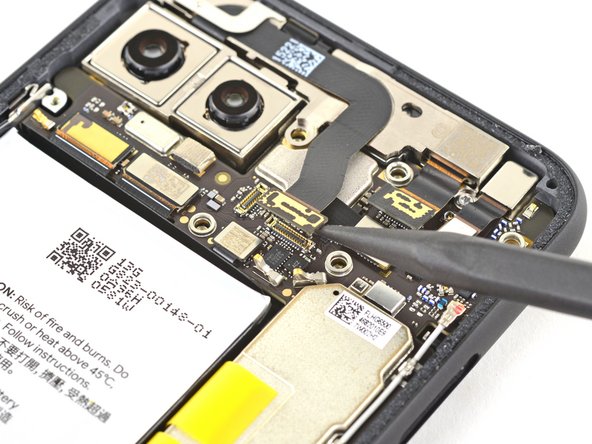Google Pixel 4 Front Camera Replacement Guide
Duration: 45 minutes
Steps: 27 Steps
This repair guide comes straight from the talented folks at Salvation Repair, and while it’s packed with great tips, it hasn’t received the official thumbs-up from Google.
Heads up:
This clear, concise repair guide will help you remove or replace the front camera and sensors on your Google Pixel 4. It’s a piece of cake! Remember, Google says messing with the laser assembly can lead to some serious invisible laser action, so be careful. You can always schedule a repair if you need help.
Step 1
– Let’s get that SIM card tray out! Use a SIM eject tool, a small bit, or a straightened paper clip. Find that tiny hole on the SIM card tray – it’s usually on the left edge of your phone.
– Gently push in to pop out the tray.
– Now, carefully remove the SIM card tray. You’re doing great!
Step 2
You can also use a hairdryer, heat gun, or hot plate, but be careful not to overheat the phone—the display and internal battery are both sensitive to heat damage. If you need help, you can always schedule a repair.
– Grab your trusty iOpener and place it on the bottom edge of the back panel. Let it chill there for a minute to warm things up!
Tools Used
Step 3
– Alright, let’s get that back panel off! Stick a suction cup on the heated edge of the back panel. Press down on it to make it stick, making sure to get as close to the edge as possible.
Feeling adventurous today? Well, give it a shot! If your back glass is feeling a bit tempestuous and cracking up, why not give it a stylish makeover with a layer of cool clear packing tape? This might be just enough to help Johnny Suction Cup stick around longer. Know what else works? That’s right, some extra strong tape can be your knight in shiny armor. Don’t worry if things don’t stick right away though, you can always resort to the trusty superglue solution. So, if you get stuck, remember that our friendly folks are always here to help. Want to give it another try? You can always schedule a repair!
Step 4
Depending on how old your phone is, this might be a bit tricky. Don’t worry! If you’re having trouble, just give that edge a little extra heat and try again. If you’re still stuck, you can always schedule a repair.
– Give that suction cup a good pull! You want to create a nice little gap between the back panel and the frame.
– Now, take the tip of your opening pick and slide it right into that gap.
Step 5
– Let’s get this party started by sliding that opening pick across the bottom towards the left corner – time to slice that adhesive!
– Keep the pick in there, and now slide it from the bottom left corner over to the bottom right corner. We’re cutting through that adhesive like butter!
– Leave that pick in the bottom right corner so that adhesive doesn’t sneak back together. We’re almost there!
Step 6
– Grab your trusty iOpener and give it a warm hug on the left edge of the phone for a solid minute. You’re doing great!
Tools Used
Step 7
– Slide a second opening pick right under the back panel, aiming for that sweet spot right over the charge port.
– Gently glide the opening pick down to the bottom left corner of your phone.
Step 8
The adhesive can get pretty sticky! Wiggle the pick in and out with a gentle sawing motion to slice through it like a pro.
– Alrighty, slide your trusty opening pick around that bottom left corner and keep on truckin’ across the left side of your phone to work on slicing that adhesive!
– Now, when you reach the top left corner, give a little high-five to the camera, and leave that pick doin’ its thang.
Step 9
– Warm up your trusty iOpener and place it snugly against the right edge of the phone for a full minute. It’s like giving your device a warm hug, helping to make all those tricky repairs a breeze!
Tools Used
Step 10
– Keep those first two opening picks right where they are – they’re doing great! Now, slide a third pick onto the lower part of the right side. Think of it like a little dance party for your picks.
– Slide that third pick up towards the top of the phone, like you’re giving the adhesive a high-five. You’re loosening it up, buddy!
– Stop when you reach the top right corner and leave that pick in place. You’ve earned a break, go grab a snack!
Step 11
– Now, we’re gonna do a little dance with our trusty opening pick. Slide that third pick around the top right corner, like you’re waltzing across the phone’s top side. This will slice through the last bit of adhesive, and we’re almost there!
Step 12
– Alright, now that you’ve sliced around the phone’s perimeter like a skilled sushi chef, gently lift the right edge of the back cover. Think of it like opening a cool book!
– Don’t try to pull the panel all the way off just yet, it’s still hanging out with the phone. We’ll get to that part soon, but for now, take it easy. If you need help, you can always schedule a repair
Step 13
– Keep swinging that back panel open until it comfortably rests on the left edge of your phone. Remember, be gentle with that ribbon cable attached – it’s more delicate than it looks!
– When you’re putting everything back together, this is a great moment to power up your phone and check that everything’s working smoothly before sealing up the back panel. Just make sure to turn your phone off completely before diving back into the repair!
Step 14
Stay organized during this repair by keeping track of each screw and making sure it ends up back in its original spot. If you need help, you can always schedule a repair
– Let’s get those battery connector shield screws out! You’ll need to remove five T3 Torx screws – four are 4.0 mm and the last one is a 2.1 mm.
Step 16
Be careful when using the spudger near the battery – we don’t want any accidental punctures. If you’re not comfortable with this step, don’t worry, you can always schedule a repair
– Time to disconnect the battery! Use the pointed end of a spudger to carefully pry the battery connector straight up from the motherboard. This will safely disconnect the battery.
– Now, let’s get that connector back in place. To reattach press connectors like this one, align it just right and gently press down on one side until you hear that satisfying click. Then, repeat the process on the other side. Remember, don’t press down on the middle, or you might end up bending those pins and causing some damage. If you need help, you can always schedule a repair
Tools Used
Step 17
– Using the flat end of a spudger, carefully fold the battery cable over so it doesn’t accidentally make contact during the rest of your repairs. This helps to keep things safe and sound, and it’s a pretty cool trick! If you need help, you can always schedule a repair
Tools Used
Step 18
– Grab your T3 Torx driver and smoothly remove those two 4 mm screws holding down the back panel connector cover. If you need help, you can always schedule a repair.
Step 20
– Let’s get that back panel connector unplugged! Using the pointed end of your trusty spudger, gently pry it up and disconnect it. You got this! If you need a hand, you can always schedule a repair.
Tools Used
Step 21
– Take off the back panel – it’s the first step to getting your device fixed up.
– When you’re putting everything back together, be sure to check out our guide on how to install custom-cut adhesives for your device.
– If you’re using a pre-cut adhesive card, follow along with this guide for a smooth repair process. And remember, if you need help, you can always schedule a repair
Step 22
– Grab your T3 Torx screwdriver and give those four 4mm screws holding the camera connector cover in place a little twist. Time to set them free!
Step 24
– Now, grab your trusty spudger and use the pointed end to gently pry the camera and sensor connectors straight up from the motherboard. It’s like giving them a little high five!
Tools Used
Step 25
– Hey, you’re doing great! Let’s unplug that funky laser module connector and give it a well-deserved break. If you need help, you can always schedule a repair!
Step 26
– Let’s take a peek at that front camera! Grab your trusty T3 Torx screwdriver and give those two tiny 2.4 mm screws holding the front camera and sensor assembly in place a gentle twist goodbye. You’re doing great!
Step 27
– Grab your trusty tweezers and give that front camera and sensor assembly a gentle nudge. It’s time to say goodbye!
Tools Used
























































